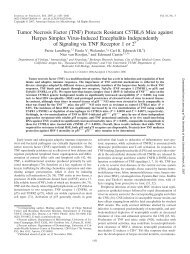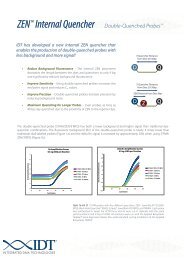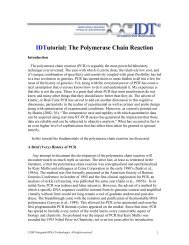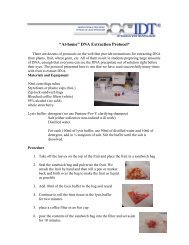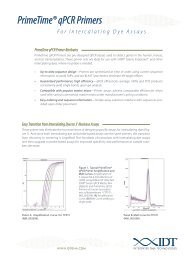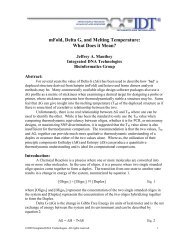products - Integrated DNA Technologies
products - Integrated DNA Technologies
products - Integrated DNA Technologies
Create successful ePaper yourself
Turn your PDF publications into a flip-book with our unique Google optimized e-Paper software.
INTEGRATED<strong>DNA</strong>TECHNOLOGIESPRODUCTSAPPENDIXMelting TemperatureMelting temperature (T m ) is the temperature at which an oligonucleotide duplex is 50% in single-stranded form and 50% in doublestrandedform. IDT’s online Oligo Analyzer estimates T m from the nearest-neighbor two-state model, which is applicable to short <strong>DNA</strong>duplexes,ΔH°T m (°C) = - 273.15ΔS° + R 1n[oligo]where ΔH° (enthalpy) and ΔS° (entropy) are the melting parameters calculated from the sequence and the published nearest neighborthermodynamic parameters, R is the ideal gas constant (1.987 cal. K-1mole-1), [oligo] is the molar concentration of an oligonucleotide,and the constant of -273.15 converts temperature from Kelvin to degrees of Celsius. The most accurate, nearest-neighbor parameters wereobtained from the following publications for <strong>DNA</strong>/<strong>DNA</strong> base pairs (Allawi, H., SantaLucia, J.,Jr., Biochemistry, 36, 10581), RNA/<strong>DNA</strong> base pairs(Sugimoto, N. et al., Biochemistry, 34, 11211), RNA/RNA base pairs (Xia, T. et al., Biochemistry, 37, 14719), and LNA/<strong>DNA</strong> base pairs (McTigue,P.M. et al., Biochemistry, 43, 5388).T m calculations for oligonucleotides containing non-consecutive, isolated LNA nucleotides hybridized to a <strong>DNA</strong> template utilize LNAenergetic parameters from McTigue, P.M. et al. All other LNA nucleotides (i.e., consecutive LNA bases on a <strong>DNA</strong> template or any LNAnucleotides on an RNA template) are approximated because nearest-neighbor parameters for these types of base pairs have yet to bepublished. Applications requiring extremely accurate predictions of the T m for LNA-containing oligonucleotides should be reviewed with atechnical support representative from Exiqon, Inc. (www.exiqon.com)T m depends on monovalent salt concentration ([Na + ]) of the solvent. The linear T m correction has been typically used in the past. Scientistsat IDT performed a large set of UV melting experiments (~3000 measurements) on about 100 short <strong>DNA</strong> duplexes in a variety of sodiumbuffers and determined that this linear function is inaccurate. OligoAnalyzer employs the improved quadratic T m salt correction function(Owczarzy,R. et al., Biochemistry, 43, 3537),1 1= + (4.29f(GC) - 3.95) x 10 -5 In[Na + ] + 9.40 x 10 -6 In 2 [Na + ]T m (Na + ) T m (1MNa + )where f(GC) is the fraction of GC base pairs.ModificationsModified oligonucleotides also need special consideration to ensure accuracy when calculating molecular weight, extinction coefficient(ε 260), and melting temperature (T m ). Modifications can change oligo mass, and sometimes alter UV absorbance or T m .Examples:Molecular Weight of an oligo containing an NHS Ester modification (such as 5’ Texas Red® NHS Ester) is a sum of molecular weights of nativeoligo, the fluorophore group, and an amino modifier.Extinction Coefficients (ε 260) of modifications, such as fluorophores and base analogs, are usually added to the ε 260of the nativeoligonucleotide. Calculations for base analogs (e.g., 5-bromo dC) and conjugated bases (e.g., fluorescein dT) are more complex. First, ε 260ofan oligo containing the unmodified base is calculated. An adjustment is made later for the contribution of the modification (fluorophore).Unfortunately, ε 260values are not known for all modifications.Melting Temperature (T m ) can be changed when nucleotides are modified or additional chemical groups are added. For example,introduction of phosphorothioated residues decreases T m significantly. In contrast, LNA nucleotides increase T m . Unfortunately, nearestneighbor thermodynamic parameters have not been determined for a majority of these modifications. Therefore, no accurate parametersand physical models exist that would allow us to calculate melting temperatures for many modified oligonucleotides. Internal basemodifications (e.g., biotin-dT), could collide and interfere with the duplex structure. Because the quantitative effects of interferenceare unknown, they are neglected. If thermodynamic parameters are not available, OligoAnalyzer reports T m values for the unmodifiedsequence. Melting temperature changes caused by modifications may be approximated from the published literature. If needed, a preciseT m can be measured experimentally.©2008 <strong>Integrated</strong> <strong>DNA</strong> <strong>Technologies</strong> 90 www.idtdna.com



